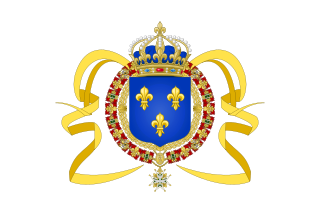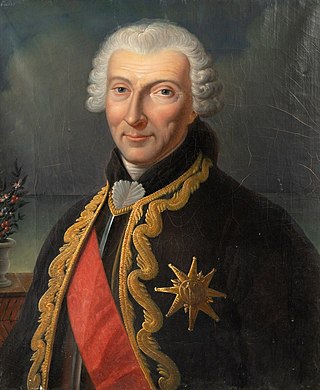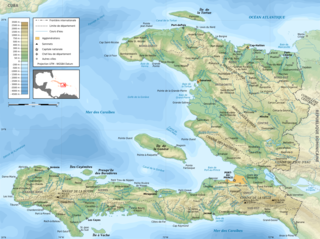Related Research Articles
The recorded history of Haiti began in 1492, when the European captain and explorer Christopher Columbus landed on a large island in the region of the western Atlantic Ocean that later came to be known as the Caribbean. The western portion of the island of Hispaniola, where Haiti is situated, was inhabited by the Taíno and Arawakan people, who called their island Ayiti. The island was promptly claimed for the Spanish Crown, where it was named La Isla Española, later Latinized to Hispaniola. By the early 17th century, the French had built a settlement on the west of Hispaniola and called it Saint-Domingue. Prior to the Seven Years' War (1756–1763), the economy of Saint-Domingue gradually expanded, with sugar and, later, coffee becoming important export crops. After the war which had disrupted maritime commerce, the colony underwent rapid expansion. In 1767, it exported indigo, cotton and 72 million pounds of raw sugar. By the end of the century, the colony encompassed a third of the entire Atlantic slave trade.

Saint-Domingue was a French colony in the western portion of the Caribbean island of Hispaniola, in the area of modern-day Haiti, from 1659 to 1804. The name derives from the Spanish main city on the island, Santo Domingo, which came to refer specifically to the Spanish-held Captaincy General of Santo Domingo, now the Dominican Republic. The borders between the two were fluid and changed over time until they were finally solidified in the Dominican War of Independence in 1844.

Coffee is a beverage prepared from roasted coffee beans. Darkly colored, bitter, and slightly acidic, coffee has a stimulating effect on humans, primarily due to its caffeine content. It has the highest sales in the world market for hot drinks.

Sugar plantations in the Caribbean were a major part of the economy of the islands in the 18th, 19th, and 20th centuries. Most Caribbean islands were covered with sugar cane fields and mills for refining the crop. The main source of labor, until the abolition of chattel slavery, was enslaved Africans. After the abolition of slavery, indentured laborers from India, China, Portugal and other places were brought to the Caribbean to work in the sugar industry. These plantations produced 80 to 90 percent of the sugar consumed in Western Europe, later supplanted by European-grown sugar beet.
A plantation economy is an economy based on agricultural mass production, usually of a few commodity crops, grown on large farms worked by laborers or slaves. The properties are called plantations. Plantation economies rely on the export of cash crops as a source of income. Prominent crops included cotton, rubber, sugar cane, tobacco, figs, rice, kapok, sisal, and species in the genus Indigofera, used to produce indigo dye.

Slavery in the British and French Caribbean refers to slavery in the parts of the Caribbean dominated by France or the British Empire.

The history of coffee dates back to centuries of old oral tradition in modern-day Ethiopia and Yemen. It was already known in Mecca in the 15th century. Also, in the 15th century, Sufi monasteries in Yemen employed coffee as an aid to concentration during prayers. Coffee later spread to the Levant in the early 16th century; it caused some controversy on whether it was halal in Ottoman and Mamluk society. Coffee arrived in Italy the second half of the 16th century through commercial Mediterranean trade routes, while Central and Eastern Europeans learned of coffee from the Ottomans. By the mid 17th century, it had reached India and the East Indies.

Gabriel-Mathieu Francois D'ceus de Clieu was a French naval officer and the governor of Guadeloupe from 1737 to 1752 and the founder of Pointe-à-Pitre. He was awarded the rank of commander of the Royal and Military Order of Saint Louis.

Coffee culture is the set of traditions and social behaviors that surround the consumption of coffee, particularly as a social lubricant. The term also refers to the cultural diffusion and adoption of coffee as a widely consumed stimulant. In the late 20th century, espresso became an increasingly dominant drink contributing to coffee culture, particularly in the Western world and other urbanized centers around the globe.
Nicaragua produces coffee, cotton, bananas, sugar and beef cattle.

The primary form of agriculture in Sri Lanka is rice production. Rice is cultivated during Maha and Yala seasons. Tea is cultivated in the central highlands and is a major source of foreign exchange. Vegetables, fruits and oilseed crops are also cultivated in the country. There are two Agriculture Parks abbreviated as A. Parks established by the Department of Agriculture. Out of the total population in Sri Lanka, 27.1% engages in agricultural activities. Agriculture accounted for 7.4% of the GDP in 2020.
Agriculture continued to be the mainstay of the economy of Haiti in the late 1980s; it employed approximately 66 percent of the labor force and accounted for about 35 percent of GDP and for 24 percent of exports in 1987. The role of agriculture in the economy has declined severely since the 1950s, when the sector employed 80 percent of the labor force, represented 50 percent of GDP, and contributed 90 percent of exports. Many factors have contributed to this decline. Some of the major ones included the continuing fragmentation of landholdings, low levels of agricultural technology, migration out of rural areas, insecure land tenure, a lack of capital investment, high commodity taxes, the low productivity of undernourished animals, plant diseases, and inadequate infrastructure. Neither the government nor the private sector invested much in rural ventures; in FY 1989 only 5 percent of the national budget went to the Ministry of Agriculture, Natural Resources, and Rural Development. As Haiti entered the 1990s, however, the main challenge to agriculture was not economic, but ecological. Extreme deforestation, soil erosion, droughts, flooding, and the ravages of other natural disasters had all led to a critical environmental situation.
Hawaii is one of the few U.S. states where coffee production is a significant economic industry – coffee is the second largest crop produced there. The 2019–2020 coffee harvest in Hawaii was valued at $102.9 million. As of the 2019-2020 harvest, coffee production in Hawaii accounted for 6,900 acres of land

Brazil produces about a third of the world's coffee, making the country by far the world's largest producer. Coffee plantations, covering some 27,000 km2 (10,000 sq mi), are mainly located in the southeastern states of Minas Gerais, São Paulo and Paraná where the environment and climate provide ideal growing conditions.

Coffee has been grown in Cuba since the mid-18th century. Boosted by French farmers fleeing the revolution in Haiti, coffee farms expanded from the western plains to the nearby mountain ranges. Coffee production in eastern Cuba significantly increased during the 19th and early 20th centuries. At its peak production, Cuba exported more than 20,000 metric tons of coffee beans per year in the mid-1950s. After the Cuban Revolution and the nationalization of the coffee industry, coffee production slowly began to decline until it reached all time lows during the Great Recession. Once a major Cuban export, it now makes up an insignificant portion of Cuban trade. By the 21st century, 92 percent of the country's coffee was grown in area of the Sierra Maestra mountains. All Cuban coffee is exported by Cubaexport, which pays regulated prices to coffee growers and processors.

Slavery in Haiti began after the arrival of Christopher Columbus on the island in 1492 with the European colonists that followed from Portugal, Spain and France. The practice was devastating to the native population. Following the indigenous Tainos' near decimation from forced labor, disease and war, the Spanish, under initial advisement of the Catholic priest Bartolomé de las Casas and with the blessing of the Catholic church, began engaging in earnest during the 17th century in the forced labor of enslaved Africans. During the French colonial period, beginning in 1625, the economy of Saint-Domingue, was based on slavery; conditions on Saint-Domingue became notoriously bad even compared to chattel slavery conditions elsewhere.

Coffee production in Martinique dates to 1723 and its establishment is credited to the French naval officer Gabriel de Clieu. It later spread to other places in the Caribbean and South America from Martinique, an overseas region of France.

Coffee production in Guadeloupe, an overseas region of France in the Caribbean Sea, has had commercial importance at various times in its history. The island's coffee heritage is being promoted through ecotourism.

The planter class was a racial and socioeconomic caste which emerged in the Americas during European colonization in the early modern period. Members of the caste, most of whom were settlers of European descent, consisted of individuals who owned or were financially connected to plantations, large-scale farms devoted to the production of cash crops in high demand across Euro-American markets. These plantations were operated by the forced labour of slaves and indentured servants and typically existed in tropical climates, where the soil was fertile enough to handle the intensity of plantation agriculture. Cash crops produced on plantations owned by the planter class included tobacco, sugarcane, cotton, indigo, coffee, tea, cocoa, sisal, oil seeds, oil palms, hemp, rubber trees and fruits. In North America, the planter class formed part of the American gentry.
Benguet coffee, also known as Benguet arabica, is a single-origin coffee varietal grown in the Cordillera highlands of the northern Philippines since the 19th century. It belongs to the species Coffea arabica, of the Typica variety. It is one of the main crops of farmers in the province of Benguet, which has a climate highly suitable for arabica cultivation. Benguet coffee is listed in the Ark of Taste international catalogue of endangered heritage foods by the Slow Food movement.
References
- ↑ Ukers 1922, p. 281.
- ↑ "Exportations par produit" (PDF). Banque de la Republic d'Haïti. Archived from the original (PDF) on 2015-09-23. Retrieved 2015-04-24.
- ↑ Ukers 1922 , p. 9
- ↑ Pan American Union, ed. (1902). Coffee: Extensive Information and Statistics. U.S. Government Printing Office. p. 42. Retrieved May 3, 2017.
- ↑ Cochet, Jean-Benoît-Désiré (1862). Galerie dieppoise: notices biographiques sur les hommes célèbres ou utiles (in French). E. Delevoye. p. 178. Retrieved 3 May 2017.
- ↑ Lacour, p. 235f. Lacour quotes dispatches mentioning de Clieu's "soins...pour la culture du café et pour sa distribution dans la colonie", but not its introduction.
- ↑ Ukers 1922 , p. 6
- ↑ Henri Welter, Essai sur l'histoire du café, Paris, 1868 full text at Internet Archive, p. 20.
- ↑ Guitar, Antony (2005). Coffee: A Dark History. W. W. Norton & Company. p. 124. ISBN 0393060713 . Retrieved 3 May 2017.
- ↑ Pendergrast 2001 , p. 17
- ↑ Pendergrast, Mark (2010). Uncommon Grounds: The History of Coffee and How It Transformed Our World. Basic Books. p. 18. ISBN 978-0-465-02404-9 . Retrieved May 3, 2017.
- ↑ Press, ed. (July 1920). "The Tea & Coffee Trade Journal, Volume 39 (U.S. Uses More Haiti Coffee)". Tea and Coffee Trade Journal Company. pp. 52–53. Retrieved 3 May 2017.
- 1 2 Ward Barber, Jenniffer. "Haiti's Coffee: Will it Come Back?".
- ↑ "Haiti Agriculture". U.S. Library of Congress.
- ↑ "Cash Crops". U.S. Library of Congress.
- ↑ Arias, Diego; Brearley, Emily; Damais, Gilles, eds. (2006). "Restoring The Competitiveness of the Coffee Sector in Haiti" (PDF). Inter-American Development Bank. Archived from the original (PDF) on 12 August 2018. Retrieved 11 August 2018.
Bibliography
- Pendergrast, Mark (2001) [1999]. Uncommon Grounds: The History of Coffee and How It Transformed Our World. London: Texere. ISBN 1-58799-088-1.
- Ukers, William H. (1922). All About Coffee. The Tea and Coffee Trade Journal Company – via Hathi Trust.